Inside: Everything you need to know about caring for baby chicks and how to get started raising baby chickens at home.
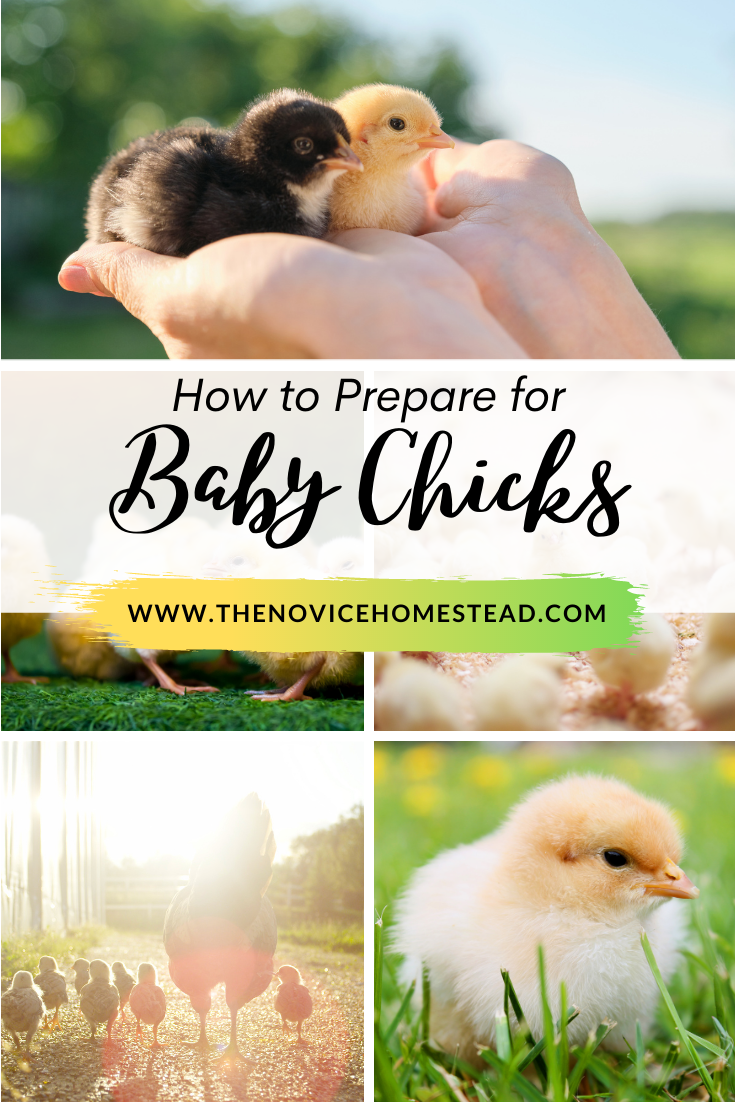
Caring for baby chicks can be as expensive as you want to make it…or it can be a totally thrifty operation! You don’t need to spend a lot of money to keep happy and healthy chicks!
In this post I’ll show you how we set up our brooder box, what we fed our baby chicks, and the basics for getting started with your new flock.
What You Need to Care for Baby Chicks
You really only need a few simple things to care for baby chicks in their first few weeks of life. You don’t need to spend a lot of money on fancy equipment. The most important things are keeping them clean, fed, warm, and safe.
Note: We’ve included shop-able ad links to products we love and use for caring for baby chicks; read our disclosure policy here.
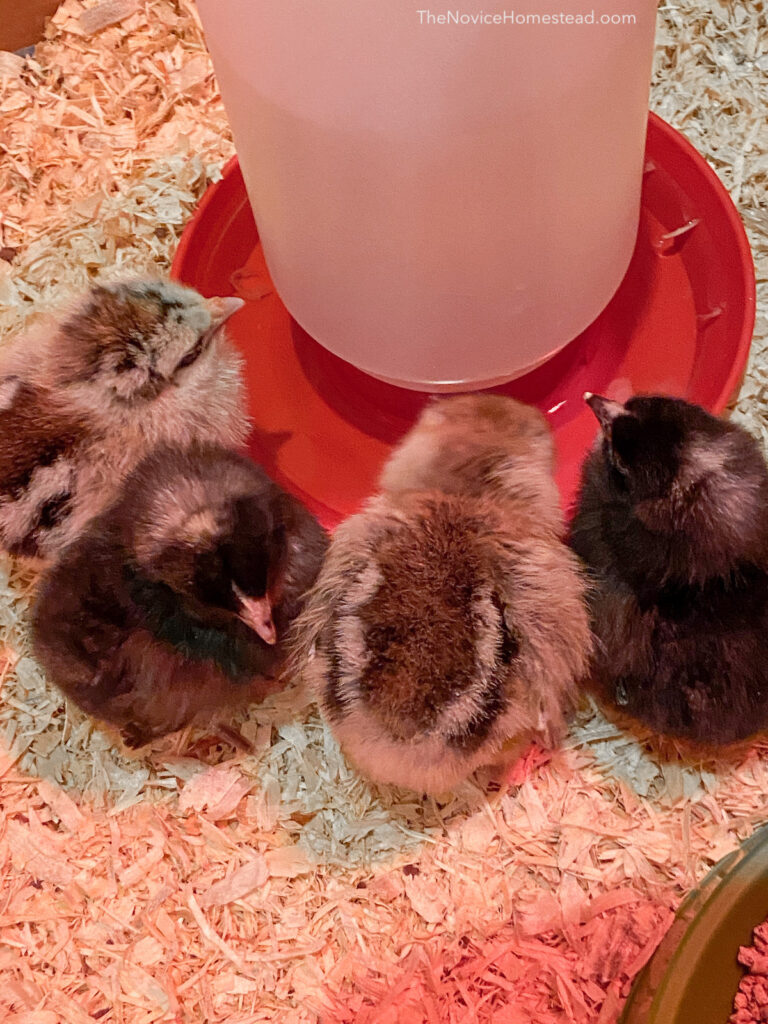
Here are the basic supplies needed when caring for baby chicks:
- Box (we use recycled cardboard boxes)
- Bedding (we use pine shavings)
- Heat lamp
- Chick feeder
- Chick waterer
- Starter feed
How to Set Up a Brooder Box
We keep our box simple, so it’s easy to clean and inexpensive. We save any shipping boxes that we get so we always have a few on hand in case one gets to dirty.
We use a dog pee pad in the bottom of the box to absorb messes and spills. Last time around we used newspaper, but this got wet really quickly and the chicks picked it apart too. The pee pads worked amazingly when the chicks knocked over their waterer — the pad soaked up all the water and the box was salvageable!
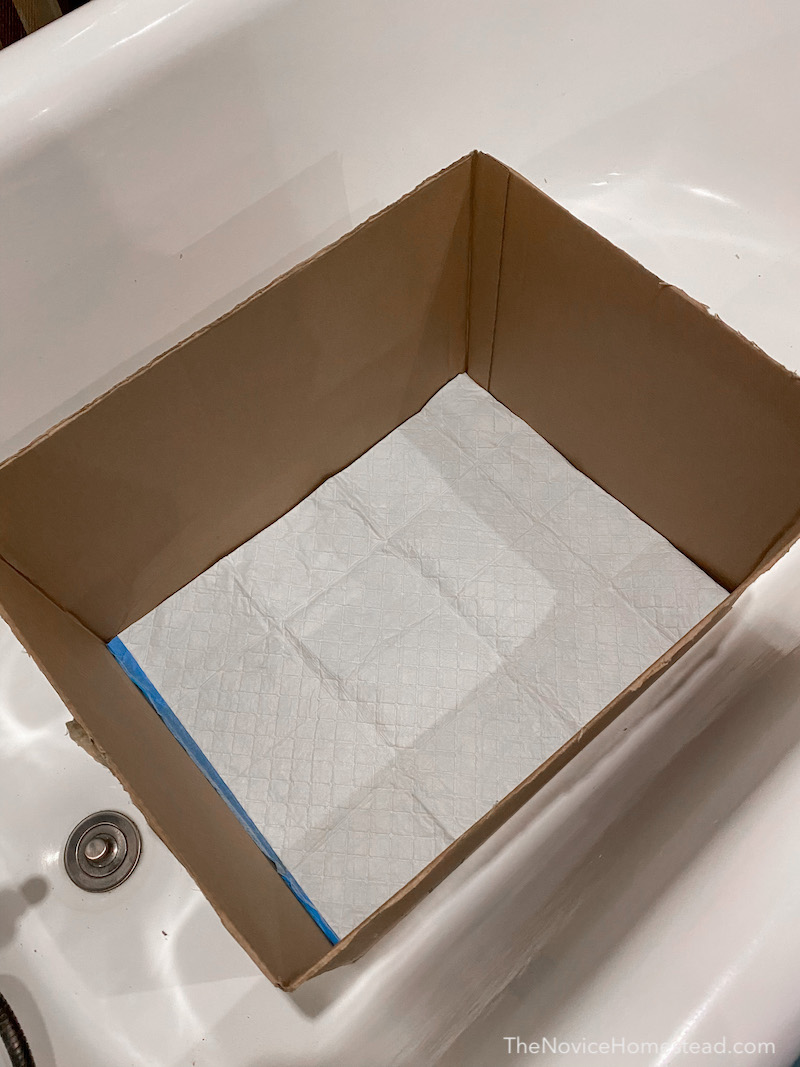
On top of the pee pad we add a couple inches of clean pine shavings, their waterer, and feeder. We also cut a section of chicken wire to use as a lid to the box because the chicks will be able to jump out before you know it and this keeps them safely contained.
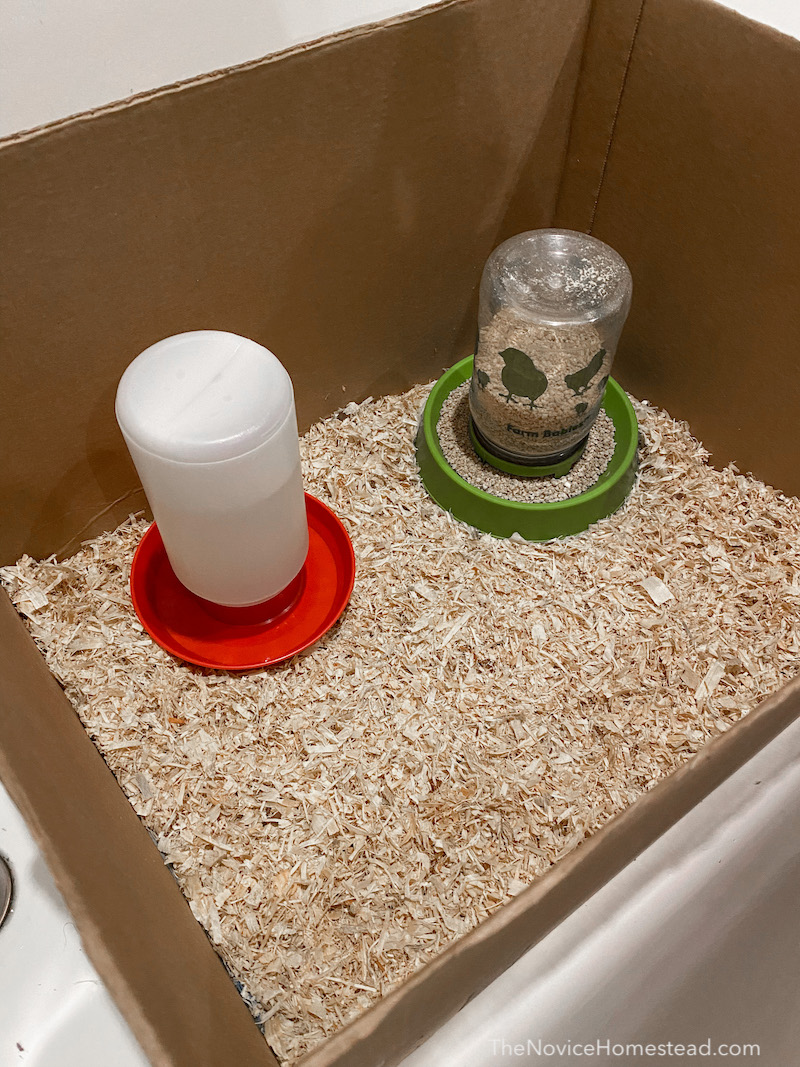
Of course, this isn’t the only way to set up a brooder box. This is just what worked for us and didn’t cost a lot of money to get started. Safety and affordability were our two main concerns and this setup did the trick!
Can You Pick Up Baby Chicks?
I’ve always been taught that it is best to handle baby chicks as often as possible so they will be easier to care for when they are bigger and faster.
We pick up each one of our babies at least once a day to talk to them and hold them for a few minutes. This strategy seemed to work, as our first group of hens (who are over a year old now) and pretty tame and we’ve been able to catch them when they escape, tend to minor wounds, etc.
However, I’ve also seen the advice that you should not handle baby chicks for the first week of their life. Because we clean our brooder ever 1-3 days (depending on how messy it gets), not handling the chicks just isn’t an option. We always pick them up and move them to a temporary holding box when we clean their brooder and replace the bedding.
Based on personal experience and because life will be easier for you if your chickens are people-friendly, I recommend handling and interacting with your babies as often as possible.
Handling chicks daily also helps you identify issues such as “pasty butt” before they become major problems.
Do Baby Chicks Need a Heat Lamp?
If they are not with a mama hen, baby chicks will need a source of heat to keep them warm until they are fully feathered. Babies are not able to regulate their body heat
One of the most common and economical sources of supplemental heat for chicks is a brooder lamp. A red light is usually recommended because it allows them to sleep better at night.
For this setup you’ll need:
- 205w infrared heat lamp
- Clamp Lamp (to hold the bulb)
For the first week of their life, baby the temperature in your baby chicks’ box should be around 95-100°F. After that, the temperature can be lowered by about 5 degrees per week, until the lamp is no longer needed. We do this by moving the light further away from the box, so the heat is less intense.
By 6-8 weeks, the heat lamp is no longer needed. That’s because the temperature that baby chicks need is usually equal to room temperature (if you are keeping them indoors).
Safety Note: Because a heat lamp can be a fire hazard, always make sure that it is properly secured and never left unattended. The biggest danger of a heat lamp is it falling into the box filled with wood shavings, newspaper, etc. which are highly flammable.
In addition to using the clamp, I’d recommend using a lamp that has a hook for hanging. This prevents it from falling into your brooder. You can also put a section of chicken wire on top of your brooder which keeps chickens from jumping out and also would keep the lamp from falling in the box.
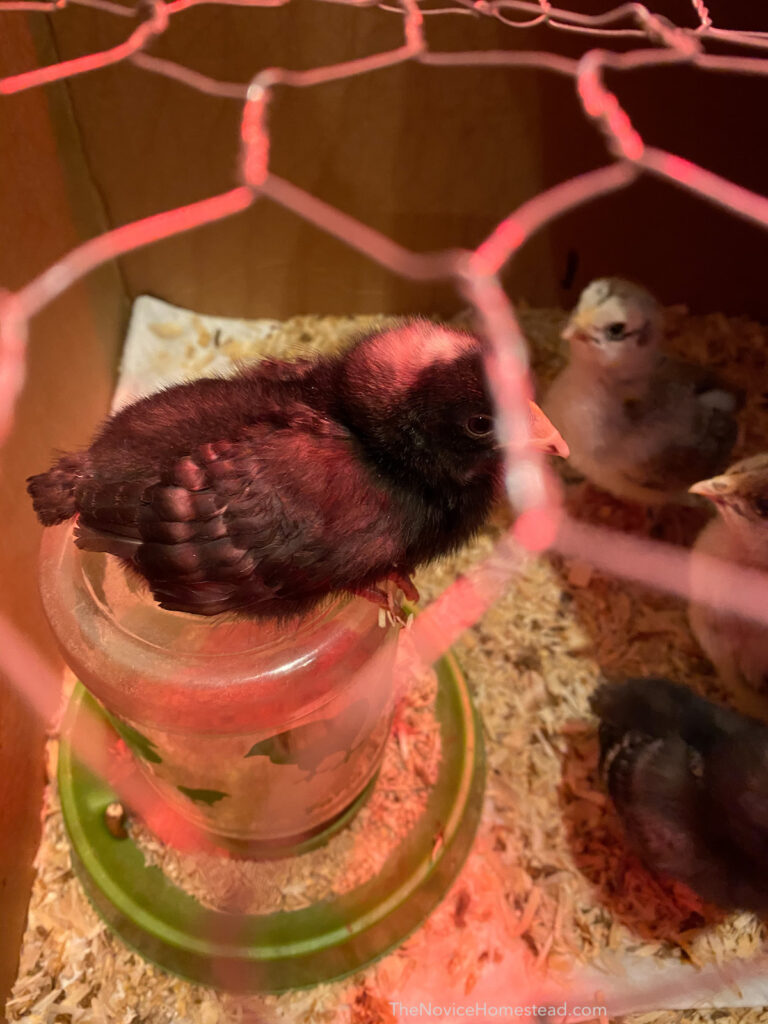
Do Baby Chickens Need Light at Night?
They don’t need a “night light” for vision purposes, but baby chickens will still need their heat lamp on at night during the first few weeks.
Using an incandescent light may make it too bright for the chicks to sleep, so an infrared heat lamp is recommended.
How Can You Tell if Chicks are Too Cold?
A thermometer is a surefire way to check the temperature of your chick habitat. However, the chicks themselves will “tell” you if the temperature is too hot or too cold.
Too Hot: Your chicks are scattered and staying as far away from the heat source as possible. They may even start panting or appear listless. Move your heat lamp a bit further away and check the temperature again.
Too Cold: You chicks are huddled together, as close as possible to the heat source. They may stop chirping to conserve energy or even start shivering. Move your heat source closer to increase the temperature of your box.
When the temperature is comfortable for your chicks, they will move about the box freely and chirp cheerfully.
What Do Baby Chicks Eat?
Baby chicks can survive the first 2 days or so of their lives without food. However, by the time you’ve picked them up from a feed store or local breeder, you’ll need to begin feeding them.
Your chicks should have access to food and water at all times. Basically, all they’re doing for the first few weeks is eating, drinking, and pooping!
For the first few weeks, the best thing for your baby chicks is a commercial starter feed. It is properly balanced with the nutrients growing chicks need.
When your chicks are a couple months old, you can begin giving them bits of leafy greens, fruits, and other things you would feed grown chickens. Always start in small amounts and incorporate new items slowly.
Related: What Kinds of Foods Can Chickens Eat?
Do Baby Chicks Need Medicated Feed?
One of the most common diseases among chickens is coccidiosis, which is caused by the parasite coccidia oocysts. Vaccination is one way to protect your baby chicks. However, if your chicks have not been vaccinated for coccidiosis, medicated starter feed is another way to prevent this illness.
Medicated feeds include a preventative that slows the growth of coccidia oocysts, so that chicks are able to build natural immunity. Once they are a couple months old, medicated feed is no longer necessary, though we kept our chicks on their same medicated feed until we switched to layer feed. I try not to switch feeds any more than necessary, as animals can be sensitive to changes in diet.
Side note: Do not switch to layer feed until your chicks have reached mature laying age (at least 18 weeks). Doing so can cause kidney damage.
If you are unsure whether or not your chicks have been vaccinated, you may want to go ahead and use medicated feed just in case. If your chicks were indeed vaccinated, the medicated feed won’t hurt anything, though it is unlikely that it provides any extra protection.
When Can Chicks Go Outside?
While they’re super cute, after a few weeks you’ll probably be counting down the days until you can kick your baby chicks out of the house!
The good news is that they can usually go outside to their “big girl” coop and run when they are around 6-8 weeks of age AND the outdoor weather is mild (remains above 60-65°F).
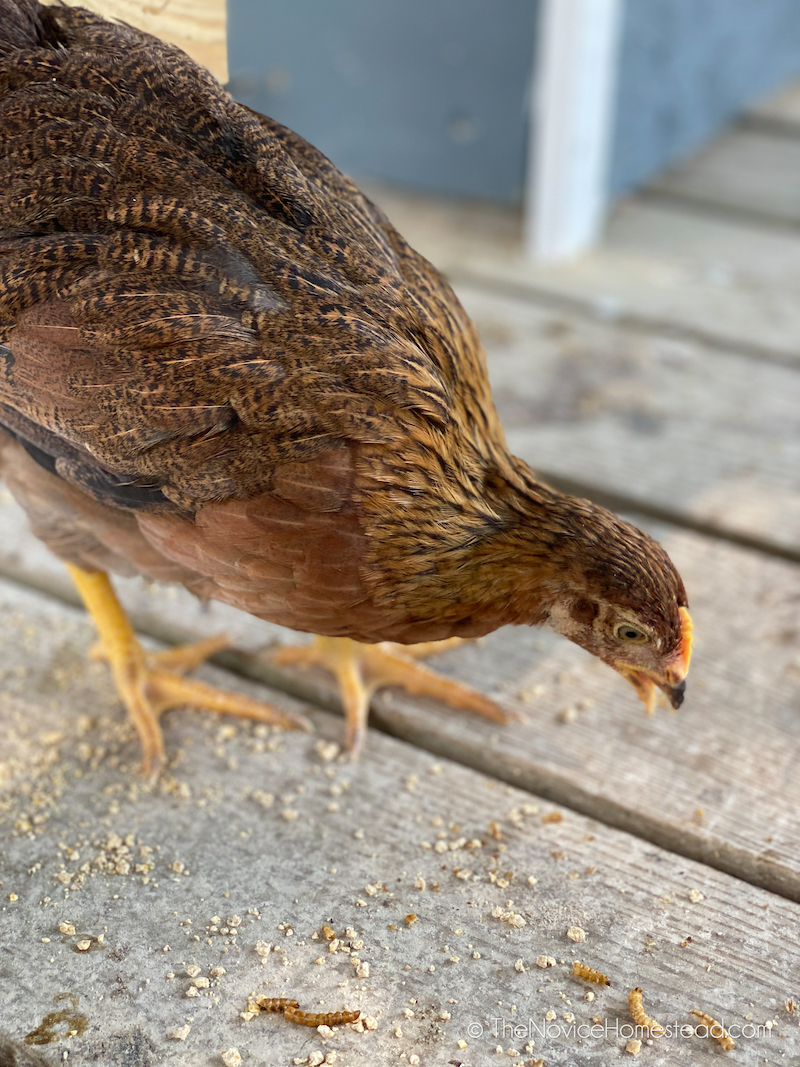
However, there may be a few instances where you’ll want to keep your chicks in the brooder a little longer.
Reasons you may want to wait to put new chickens outside:
- The weather is still too cold
- You’ll be introducing them to a larger flock
How to Introduce Baby Chickens to Your Existing Flock
This topic deserves its own blog post, as there a many different strategies for introducing chicks to older birds.
Whenever you introduce new chickens to a flock, whether they are young or old, it will temporarily upset the pecking order. All flocks have a hierarchy, and “pecking order” is just what it sounds…they sort of battle it out to determine who is the boss and where each hen stands in their group.
Adding new chickens means that the flock has to re-determine their pecking order, and their may be some scuffles. That’s why it’s important to wait until your babies are pretty much full size before you put them in a coop with older chickens — that way they can defend themselves and are less likely to be bullied.
In any case, you’ll want to closely monitor your flock for the first few days after incorporating new members, for everyone’s safety.